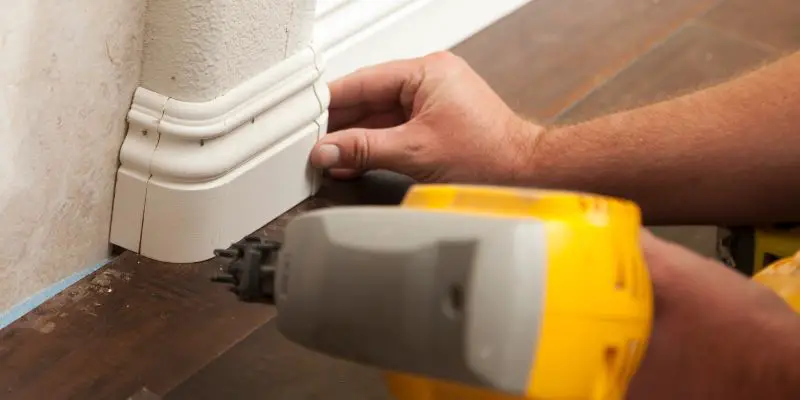For baseboards, use nails that are 2 1/2 inches in size. Properly sized nails ensure secure installation and longevity of the baseboard.
Choosing the right nail size is essential in preventing any damage or splitting of the baseboard material, and 2 1/2-inch nails fulfill this requirement effectively. These nails provide adequate depth for insertion into the baseboard and offer enough holding power for a sturdy and durable installation.
Using the correct nail size ensures a seamless and polished finish to your baseboard project.
Understanding Baseboard Nails
When it comes to baseboard nails, it’s crucial to choose the right size for a secure installation. Use 15 or 16-gauge finish nails, around 2 inches in length, to ensure the baseboards are firmly attached to the wall without any splitting or cracking.
When it comes to installing baseboards, choosing the right nail size is crucial. Baseboard nails are specifically designed for attaching baseboards to walls, ensuring a secure and long-lasting installation. Understanding the different types of baseboard nails and the importance of choosing the right nail size will help you achieve a professional finish that enhances the overall look of your space.
Different Types Of Baseboard Nails
Baseboard nails come in various types, each suited for specific installation requirements. Let’s take a closer look at the different types:
- Finishing Nails: These thin nails with small heads are commonly used for baseboard installations. Their small size allows the nails to be driven flush with the baseboard surface, resulting in a neat and clean appearance.
- Brad Nails: Similar to finishing nails, brad nails have even smaller heads and are typically used for more delicate or ornate baseboard designs. They provide a secure attachment without the risk of splitting the wood.
- Coil Nails: These nails are collated together in a coil, making them compatible with pneumatic nail guns. Coil nails facilitate faster installation and are ideal for larger baseboard projects where efficiency is key.
Importance Of Choosing The Right Nail Size
Choosing the right nail size for your baseboard installation is essential for several reasons:
- Secure Attachment: Using the correct nail size ensures that the baseboard is securely fastened to the wall, preventing any potential movement or loosening over time.
- Preventing Damage: Using nails that are too long can cause the baseboard to split or crack, while nails that are too short may not provide enough strength and stability.
- Aesthetics: The right nail size contributes to the overall appearance of the baseboard installation. Nails that are too long or have large heads may be visible and detract from the visual appeal of the finished project.
When choosing the nail size, consider the thickness of your baseboard and the material it is made of. It’s important to select a nail that is long enough to penetrate the baseboard and wall stud, but not so long that it protrudes through the front surface.
In conclusion, understanding baseboard nails and selecting the appropriate nail size is vital for a successful installation. By choosing the right type and size of nails, you can ensure a secure attachment, prevent damage, and achieve a visually pleasing result that enhances the overall look of your space.

Determining Factors For Nail Size
Determining the right nail size for baseboards depends on a few factors, such as the thickness of the baseboard and the type of wall material. Consider the length and gauge of the nail to ensure a secure and professional installation.
When it comes to installing baseboards, choosing the right nail size is crucial for securing them properly. The nail size you choose will depend on several factors, including the type of baseboard material and the wall and floor material. Let’s dive deeper into these determining factors to help you make an informed decision.
Type of Baseboard Material
The first factor to consider when determining the nail size for baseboards is the type of material used. Different baseboard materials require specific nail sizes for optimal installation. Here’s a breakdown of nail sizes commonly used with various baseboard materials:
1. Wood Baseboards:
– Use 6d or 8d finishing nails for thinner, softer wood baseboards.
– For denser or thicker wood baseboards, opt for 10d finishing nails.
2. MDF Baseboards:
– MDF (Medium-Density Fiberboard) baseboards are relatively soft and can be easily damaged by longer nails.
– To avoid any splitting or cracking, use 6d or 8d finishing nails for MDF baseboards.
3. Vinyl Baseboards:
– Vinyl baseboards are lightweight and flexible.
– Choose 6d or 8d finishing nails that are suitable for the thickness of the vinyl material.
Wall and Floor Material
The second determining factor for nail size is the material of the wall and floor to which the baseboards will be attached. Different wall and floor materials have varying degrees of hardness, requiring different nail sizes for secure installation. Consider the following:
1. Drywall:
– For drywall installations, use 6d finishing nails that are long enough to penetrate the baseboard and securely anchor into the wall studs.
– Ensure the nails are not too long, as they could pierce through the drywall surface.
2. Plaster Walls:
– Plaster walls are thicker and more solid than drywall.
– Choose longer 8d or 10D finishing nails to penetrate the baseboard, anchor in the wall studs, and securely hold the baseboards in place.
3. Concrete or Masonry Floors:
– If you’re attaching baseboards to concrete or masonry floors, you’ll need to use a different type of fastener, such as concrete nails or anchors.
– Consult with a professional or hardware store for the appropriate fastening options for these materials.
By considering the type of baseboard material and the wall and floor materials, you can determine the correct nail size for your baseboard installation. Remember, using the right nail size ensures the baseboards are securely attached and enhances the overall aesthetics of your space.
Choosing The Right Nail Size
Choosing the right nail size for baseboard installation is crucial in ensuring a secure and long-lasting finish. The size of the nails used can have a significant impact on the overall stability and durability of the baseboard. Therefore, it’s essential to carefully select the appropriate nail size based on factors such as the material of the baseboard and the surface it will be installed.
Recommended Nail Sizes For Different Baseboard Materials
When choosing the right nail size for baseboard installation, the type of material used is a key consideration. Different materials, such as wood, MDF, and composite, require specific nail sizes to ensure secure attachment and prevent damage to the baseboard.
Impact Of Nail Size On Baseboard Installation
The nail size plays a crucial role in the successful installation of baseboards. It directly affects the stability and strength of the baseboard, as well as its ability to withstand environmental factors and potential wear and tear. Using the wrong nail size can lead to loose or damaged baseboards, requiring additional repair or replacement.

Credit: www.amazon.com
Common Mistakes To Avoid
When installing baseboards, it’s important to choose the right size nail to ensure a secure and professional finish. Avoid common mistakes by selecting nails that are appropriate for the thickness and material of your baseboard, and use the correct tools and techniques to prevent splitting or damage.
Using Incorrect Nail Size
Using the wrong nail size when installing baseboards is a common mistake that can lead to a host of problems down the line. It’s important to select the right nail size to ensure that your baseboards are securely attached and properly aligned. Using nails that are too short may not provide enough support while using nails that are too long can result in visible damage to the baseboards or even the underlying wall. So, what size nail should you use for baseboards?
Neglecting Environmental Factors
Another mistake to avoid when choosing the right nail size for baseboards is neglecting the environmental factors in which they will be installed. Environmental factors such as humidity and temperature can greatly impact the stability and longevity of your baseboards.
When it comes to humidity, it’s important to consider that wood tends to expand and contract with changes in moisture levels. If you live in an area with high humidity, using nails that are too short may result in the baseboards popping out or becoming loose over time. On the other hand, if you live in a dry climate, longer nails may be necessary to ensure a secure installation.
Temperature fluctuations can also cause the baseboards to shrink or expand. If you neglect these factors and use the wrong nail size, you may find that your baseboards start to warp or buckle as the seasons change.
To avoid these issues, it’s crucial to select a nail size that takes into account the specific environmental factors of your location. Considering the average humidity and temperature levels in your area can help you make an informed decision when it comes to choosing the right nail size for your baseboards.
In conclusion, using the correct nail size and taking into account environmental factors are crucial steps to avoid common mistakes when installing baseboards. By choosing the appropriate nail size and considering the unique conditions of your location, you can ensure that your baseboards are securely installed and will stand the test of time.
Tips For Successful Baseboard Nail Selection
When installing baseboards, choosing the right nail size is crucial for a successful and secure installation. Using the wrong size can lead to problems like splitting the wood or failing joints. To help you select the perfect nail for your baseboard, we have put together some useful tips that you can follow.
Consulting With Hardware Experts
If you’re uncertain about the nail size to use, it’s always a good idea to consult with hardware experts. They have the knowledge and experience to provide you with expert advice on the right nail selection based on the specific type of baseboard and the type of material you will be attaching it to. Their expertise can save you from unnecessary hassles and ensure a smooth installation process.
Testing Nail Size On Scrap Materials
Before you begin nailing your baseboard, it’s a wise practice to test the nail size on a scrap piece of wood or similar material. This will give you an idea of how well the nail will hold and if it’s the right size for your particular baseboard. By doing this simple test, you can avoid potential issues and make any necessary adjustments before proceeding with the actual installation.
During the testing process, make sure to use different nail sizes and compare their performance. Choose the nail size that offers optimal holding power without damaging the material. This way, you can be confident that you’re using the right nail size for your baseboard installation.

Credit: mytoolkit.co.uk
Frequently Asked Questions Of What Size Nail For Baseboard
What Size Nails Do I Need For Baseboards?
For baseboards, use 2-inch to 2. 5-inch nails to secure them to the wall. Make sure the nails are long enough to penetrate the wall stud for a secure attachment. Always choose nails of the appropriate size and material for the best results.
Should I Use 16 Or 18 Gauge Nails For Trim?
For trim, it is generally recommended to use 16-gauge nails. They offer sufficient holding power and are less likely to split the wood compared to 18 gauge nails.
Can I Use 18 Gauge Nails For Baseboard?
Yes, 18 gauge nails can be used for baseboard installation. They are of appropriate size and strength for securing baseboards to walls.
What Size Finishing Nails Should I Use?
Use 15- to 18-gauge nails for finishing tasks. Thinner nails are suitable for delicate work, while thicker ones are better for heavy-duty jobs. Select the nail size based on project requirements for a secure and professional finish.
Conclusion
To sum up, choosing the right size nail for baseboard installation is crucial for a successful project. By understanding factors like baseboard material and wall type, you can ensure a secure and seamless finish. With the information provided, you can confidently select the appropriate nail size for your baseboard installation.


